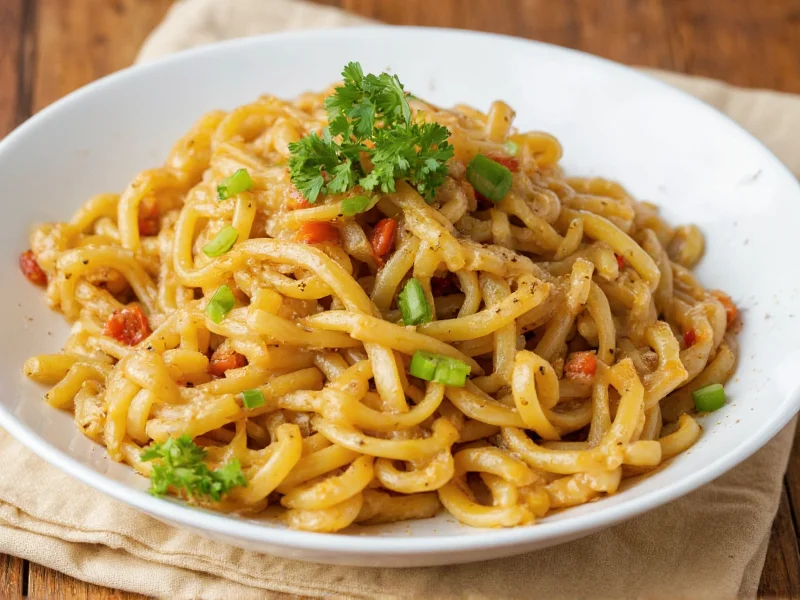Thyme isn't just for roasts and stews—it's a surprisingly versatile herb that elevates noodle dishes with its distinctive aromatic profile. This perennial herb from the mint family brings a subtle complexity that works exceptionally well with both delicate egg noodles and heartier pasta varieties. Understanding how to properly use thyme in noodle preparations can transform ordinary meals into restaurant-quality experiences.
The Culinary Science of Thyme in Noodle Dishes
Thyme contains thymol, an essential oil that provides its characteristic earthy, slightly lemony flavor. When combined with noodles, this compound interacts with starch molecules to create a more rounded flavor profile. Unlike more aggressive herbs like rosemary, thyme's moderate intensity allows it to complement rather than dominate pasta dishes.
Fresh thyme generally provides brighter flavor notes compared to dried thyme, which develops deeper, more concentrated earthiness. For most noodle applications, add fresh thyme toward the end of cooking to preserve volatile aromatic compounds, while dried thyme benefits from earlier addition to allow full flavor release.
Perfect Noodle-Thyme Pairings
Certain noodle varieties form particularly harmonious partnerships with thyme. Understanding these pairings helps create balanced dishes where neither component overwhelms the other.
| Noodle Type | Thyme Application | Flavor Enhancement |
|---|---|---|
| Fresh egg noodles | Finely chopped fresh thyme in sauce | Complements richness with herbal brightness |
| Pappardelle | Thyme-infused brown butter sauce | Enhances earthy notes in wide ribbons |
| Ramen noodles | Thyme in broth base | Adds complexity to traditional Asian flavors |
| Whole wheat pasta | Dried thyme in dough | Amplifies nutty characteristics |
Advanced Techniques for Noodle Thyme Integration
Professional chefs employ several specialized methods to maximize thyme's impact in noodle dishes. These techniques go beyond simple herb sprinkling to create integrated flavor experiences.
Thyme-Infused Cooking Water
Add several sprigs of fresh thyme to your pasta cooking water during the final two minutes of cooking. This subtle infusion allows starch molecules to absorb herbal notes directly, creating noodles with inherent flavor rather than surface-level seasoning. Remove sprigs before draining to prevent over-extraction of bitter compounds.
Compound Butter Preparation
Create thyme compound butter by blending softened butter with minced fresh thyme, lemon zest, and a pinch of sea salt. Toss freshly cooked noodles with this butter for an emulsified sauce that clings perfectly to pasta surfaces. This technique works especially well with pappardelle and fettuccine.
Thyme Oil Extraction
For delicate Asian noodle applications, prepare a light thyme oil by gently warming olive oil with thyme leaves over low heat for 15 minutes. Strain and use as finishing oil for soba or udon dishes. This method introduces subtle herbal notes without disrupting traditional flavor profiles.
Common Mistakes to Avoid with Noodle Thyme
Even experienced home cooks frequently make errors when incorporating thyme into noodle dishes. Recognizing these pitfalls ensures optimal results:
- Overcooking fresh thyme - Adding fresh thyme too early causes volatile oils to evaporate, diminishing flavor impact
- Using excessive quantities - Thyme's potency means just 1-2 teaspoons of fresh leaves typically suffices per serving
- Mismatching thyme varieties - Common thyme works best for most applications, while lemon thyme better suits seafood pasta
- Ignoring stem texture - Woody thyme stems become unpleasant when cooked with noodles; always remove before serving
Three Signature Noodle Thyme Recipes
Mediterranean Thyme Chicken Pasta
Toss cooked penne with sautéed chicken breast, cherry tomatoes, olives, and a sauce made from chicken broth, lemon juice, and 2 tablespoons fresh thyme. Finish with grated pecorino and additional thyme leaves. This dish exemplifies perfect thyme and noodle flavor pairing for weeknight dinners.
Creamy Thyme Mushroom Noodles
Combine wide egg noodles with a sauce of sautéed mushrooms, shallots, heavy cream, and 1½ tablespoons fresh thyme. The earthy mushroom notes harmonize beautifully with thyme's herbal complexity, creating a sophisticated vegetarian option that satisfies even meat lovers.
Asian-Inspired Thyme Ramen Upgrade
Elevate store-bought ramen by adding 1 teaspoon thyme-infused oil to the broth along with soft-boiled egg, scallions, and sesame seeds. The subtle herbal note transforms standard ramen into a more complex culinary experience without compromising authentic Asian flavors.
Thyme Storage for Optimal Noodle Dish Performance
Proper herb storage directly impacts flavor quality in noodle preparations. Keep fresh thyme viable longer by treating it like cut flowers—trim stems and place in a small glass with 1 inch of water, then cover loosely with a plastic bag. Store in refrigerator for up to two weeks. For longer preservation, freeze whole sprigs in olive oil using ice cube trays, then transfer to freezer bags. These thyme-infused cubes work perfectly for quick noodle sauce preparations.











 浙公网安备
33010002000092号
浙公网安备
33010002000092号 浙B2-20120091-4
浙B2-20120091-4